MARIANI’SVirtual
Gourmet
June 16,
2013
NEWSLETTER
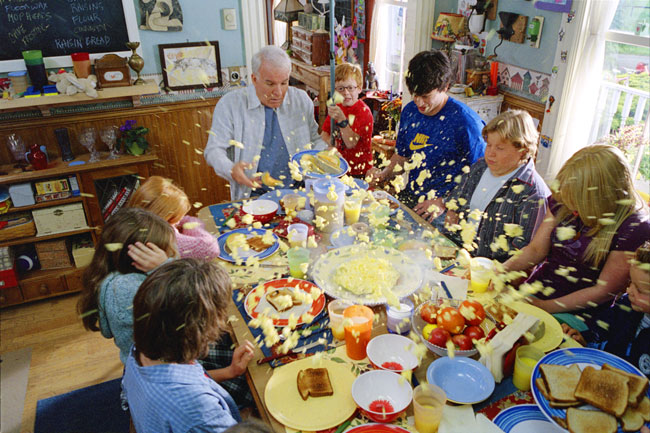
HAPPY FATHER'S DAY!
♦♦♦
THIS WEEK
A LATE LUNCH WITH MY FATHER
by John Mariani
UPSCALE
WINING & DINING
IN SOUTH AFRICA
By Geoff Kalish
NEW YORK CORNER
The Ryland Inn
by John Mariani
NOTES
FROM THE WINE CELLAR
BIG LISTS AND
HIGH PRICES: WHO BUYS THIS STUFF?
by John Mariani
♦ ♦ ♦
A LATE
LUNCH WITH MY FATHER
by John Mariani

Stony Brook, NY
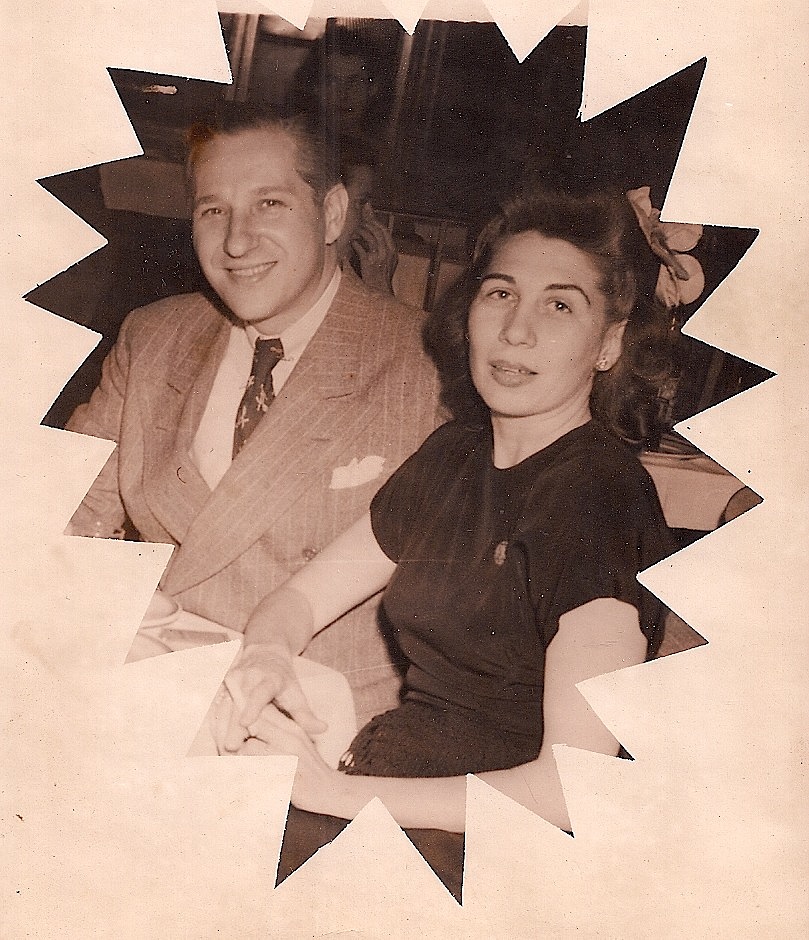 My father Al was a man of great
gusto.
My father Al was a man of great
gusto.
His father and
mother came from Italy in 1905 and afterwards they
never went hungry.
When Al asked my mother, Renee Sofia, to marry
him, his mother demanded the prospective wife learn
how to make all Al’s favorite dishes, which were all
Italian: lobster fra
diavolo, polenta, lasagna with tiny
meatballs, gnocchi, and many others. And because
my mother, also of Italian background, knew many more
American dishes, it was not unusual for our Sunday
dinners to begin with prosciutto and melon, then ziti
with meat sauce, then roast prime rib with Yorkshire
pudding and chocolate sundaes for dessert.
My parents loved going to to
dinner, at least once a week by themselves, at least
once a week with my brother and me. Usually it was to
go to a superb Italian restaurant in the Bronx named
Amerigo’s, sometimes into Manhattan to places like
Vesuvio’s and Mamma Leone’s, which back then was not
yet the tourist trap it later became.
My father knew and urged my mother
always to buy the best ingredients, but one 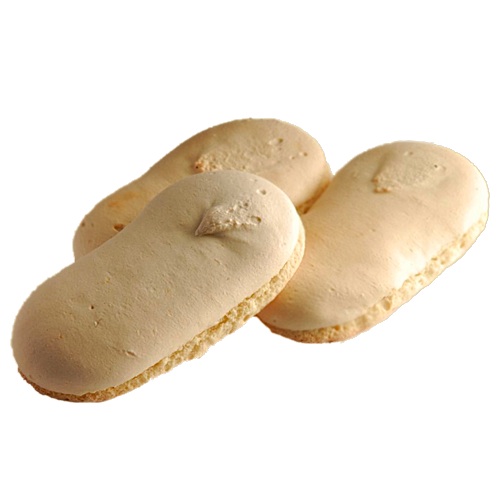 day a
week—Thursday, when he took off from his podiatry
practice early—he brought his lunch home.
day a
week—Thursday, when he took off from his podiatry
practice early—he brought his lunch home.
Although my family lived several
miles from Fordham, my father would go there on
Thursdays, and for him it was a return to his old
neighborhood, for he'd grown up on Cambrelling Avenue,
just off Arthur Avenue, and, though his people had
come from the province Abruzzi on the Adriatic, he
understood and enjoyed hearing the Neapolitan melodies
as he shopped among the vendors. He'd double
park the Chevy, signal the most proximate vendor where
he'd be in case anyone had to get out, then go into
the salumeria to buy some prosciutto, which he
demanded be sliced thin enough "so I could read Il Progresso
through it." Then
next door to Madonia Brothers for an enormous round
loaf of crusty Italian bread straight out of the oven.
While the girl wrapped the bread in
white paper and tied it with a string, he'd point to
the light, wafer-like biscuits called savoiardi (right) and say
he'd take a dozen.
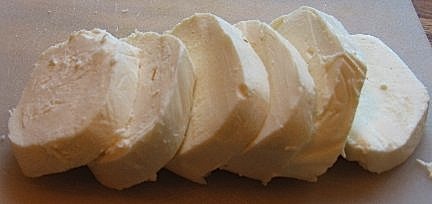 Last stop was the
cheese shop to buy a fresh mozzarella in water. Heavy,
creamy and glistening, with the heft and shape of a
woman's breast, the mozz were kept in salted water to
keep them fresh. My father would specify which one he
wanted, and the woman would ladle it out into a piece
of waxed paper, then place it in a paper carton.
Last stop was the
cheese shop to buy a fresh mozzarella in water. Heavy,
creamy and glistening, with the heft and shape of a
woman's breast, the mozz were kept in salted water to
keep them fresh. My father would specify which one he
wanted, and the woman would ladle it out into a piece
of waxed paper, then place it in a paper carton.
By the time my
father arrived home, I'd already had lunch. If it was
during the school year, the bread, prosciutto and mozz
would be my snack at three o'clock. But in
summer, I waited for my father to arrive back at our
apartment at around two o'clock, and I'd always ask,
"Did you bring some mozz home?" and he'd kid around,
scrunch up his face like he was going to say he'd
forgotten, then bring out the bag from behind his
back.
He'd
take off his jacket and hat and lay them on the living
room couch. Then he'd turn on the Victrola and put a
78 RPM 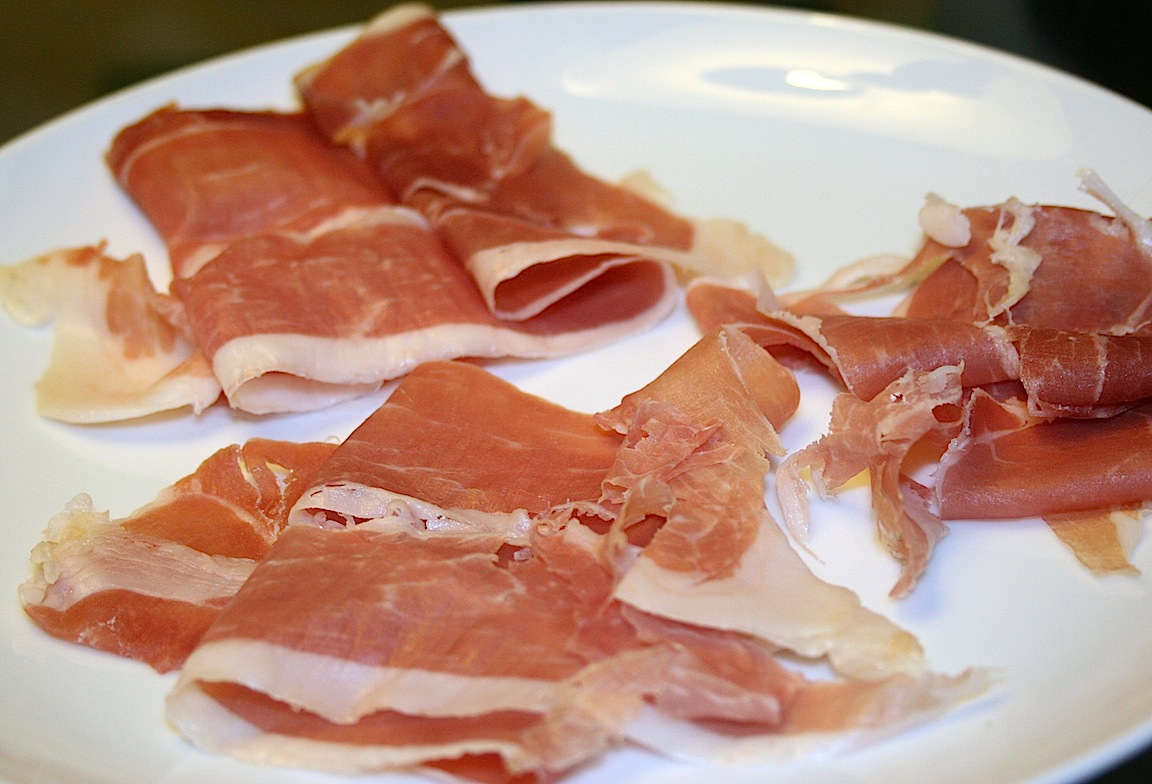 record on the turntable. It
would be Toscanini, conducting "Capriccio Italienne"
or Carmen Cavallaro playing the Toselli Serenade on
the piano. Carefully my father would then unwrap the
mozz in water, and, with the same surgical precision
and gentleness he used in treating his patients, he'd
slice the bread thin enough to absorb the flavors of
the meat and cheese but thick enough not to turn
soggy. He'd unwrap the rosy, salty slices of
prosciutto that had been laid out in impeccably neat
layers between sheets of paper so that the slices
didn't stick to one another. With a fork, he would
then deftly curl back a single slice of prosciutto.
The light would shine through it. He cut into the
yellow-white mozz that oozed milk and beaded up. It
was still a little warm when you bit into it, and the
flavors were the same week after week.
record on the turntable. It
would be Toscanini, conducting "Capriccio Italienne"
or Carmen Cavallaro playing the Toselli Serenade on
the piano. Carefully my father would then unwrap the
mozz in water, and, with the same surgical precision
and gentleness he used in treating his patients, he'd
slice the bread thin enough to absorb the flavors of
the meat and cheese but thick enough not to turn
soggy. He'd unwrap the rosy, salty slices of
prosciutto that had been laid out in impeccably neat
layers between sheets of paper so that the slices
didn't stick to one another. With a fork, he would
then deftly curl back a single slice of prosciutto.
The light would shine through it. He cut into the
yellow-white mozz that oozed milk and beaded up. It
was still a little warm when you bit into it, and the
flavors were the same week after week.
My father would
sit there in his shirt and tie, drinking a beer with
his meal. I ate slowly, stretching out the time, and
we talked about nothing in particular. But I always
felt closer to him on those days than at any other
time in my life. He would sit at the kitchen table,
bite off a morsel of his sandwich, take a sip of beer,
then close his eyes and raise his hand. "Listen," he
said very softly, as Toscanini lulled the orchestra
into a slow, sad movement. "That's very. . . very Italian."
♦ ♦ ♦
UPSCALE
WINING & DINING
IN SOUTH AFRICA
By Geoff Kalish
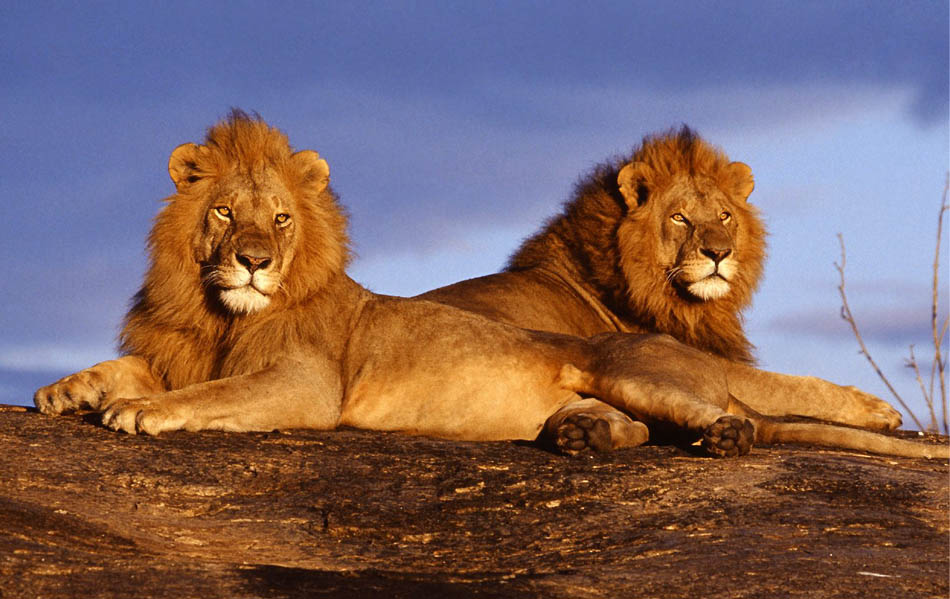
KRUGER
NATIONAL PARK
High on the
list of the many pleasures my wife and I found on a
recent three-week stint in South Africa were the many
opportunities for outstanding, extremely well-priced
upscale wining and dining. In fact, measured
against numerous upper echelon dining experiences in
the gastronomic meccas of France, Italy and the United
States, meals at South Africa’s top-tier restaurants
were a phenomenal bargain. Moreover, visiting even the
highest-rated wineries is far less an undertaking than
touring the vineyards of Bordeaux and Burgundy and
less a Disneyland-like experience than Napa Valley.
So, for those into food and wine
considering a trip to this diverse country -- boasting
one of the oldest wine industries outside Europe and
newest culinary innovations anywhere -- the following
is provided as a brief guide. (Restaurants are
discussed by location following our recent itinerary,
starting in the north, in Kruger National Park, and
concluding in Cape Town. Wineries are discussed
separately, also by location, from west to east,
starting in Hermanus and concluding in Constantia.) Of
note, our hotel and dining arrangements were made
flawlessly by Samantha Myburgh of Rhino Africa
Tours.
KRUGER NATIONAL PARK
SINGITA SABI
SANDS EBONY LODGE
Sabi Sands
Kruger National Park
(021) 683-3424
www.singita.com
While the
twice-daily guided game drives providing up-close
observation of animals in the wild are the main draw
here, this facility has from its inception touted its
spacious accommodations and superior food and wine
offerings as part of the pampering. And, during a
three-day stay we found that the excellent wine
choices and generally above average fare (both
provided on an all-inclusive price basis) definitely
added to the overall experience. In fact, in addition
to our sightings of the lions, tigers, elephants,
hippos and buffalo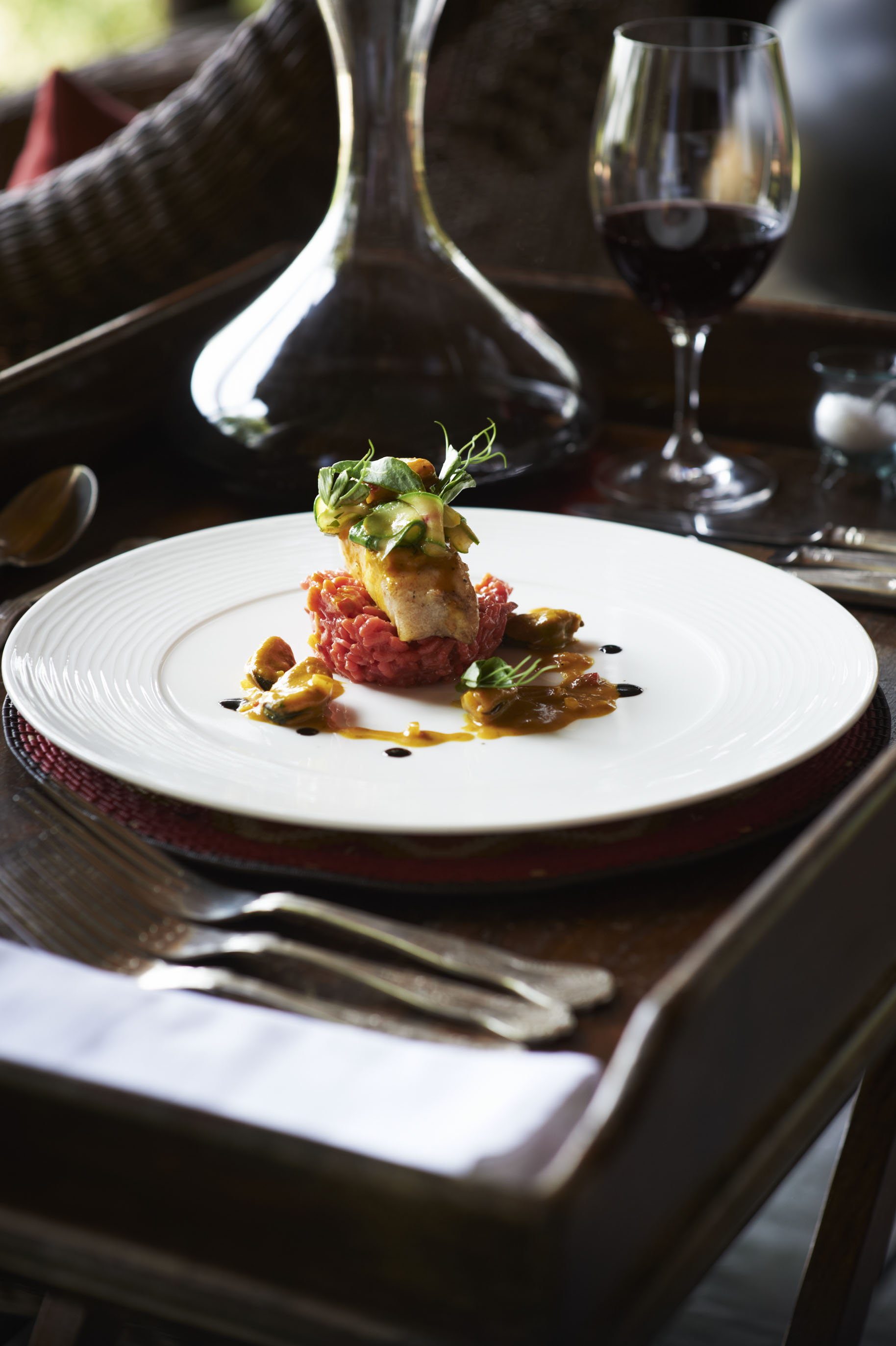 in their
natural habitat, the private tasting of Syrah-based
wines conducted by sommelier Francois Rautenbach was
one of our most memorable experiences at the lodge.
in their
natural habitat, the private tasting of Syrah-based
wines conducted by sommelier Francois Rautenbach was
one of our most memorable experiences at the lodge.
Breakfast and lunches were a
combination of buffet and à la carte ordering,
highlighting local produce. Dinners ranged from an
outdoor barbecue buffet, offering a variety of salads,
local vegetables and grilled game (which we found
severely overcooked), to a luxurious private dining
experience in the lodge’s library, with choices
running the gamut from a zesty dish of tender calamari
Asian stir fry with coriander and a sweet chili sauce
to a bursting-with-flavor char-grilled springbok loin
with a cinnamon espresso glaze. A juicy sesame-crusted
salmon was doused with a soy buerre blanc, while
a decadent malva pudding came with amarula ice cream.
As to the wine choices here, guests
can chose to accompany meals with unlimited
quantities of whatever they want from a wide selection
of many of the top South African brands, like elegant
chardonnays from Hamilton Russell, complex cabernet
sauvignons from Jordan and syrahs from
Boekenhoutskloof, which even in their youth show layer
upon layer of well integrated fruit, spice and herbs.
The price, including
lodging, game drives, wine and food, starts at
$1,250 per person per night.
JOHANNESBURG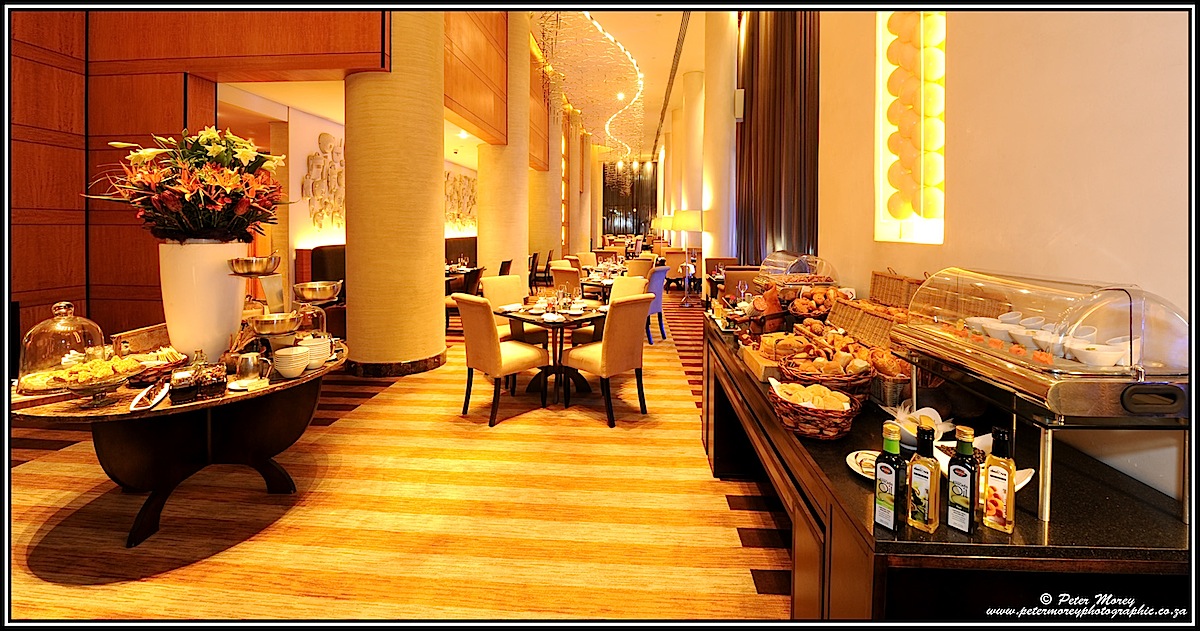
QUILLS
Intercontinental Hotel Sun, OR Tambo Airport
(011) 961-5400
www.intercontinental.com
One of the many
unexpectedly pleasant dining experiences on our trip,
several cuts above average for the genre, was
dinner at this restaurant located on the ground floor
of an airport hotel, where we stayed one night
en route from Zambia to the Western Cape. The space
housing the restaurant is rather cavernous, featuring
an eye-catching sixty-foot long mobile of porcupine
quills surrounded by tall round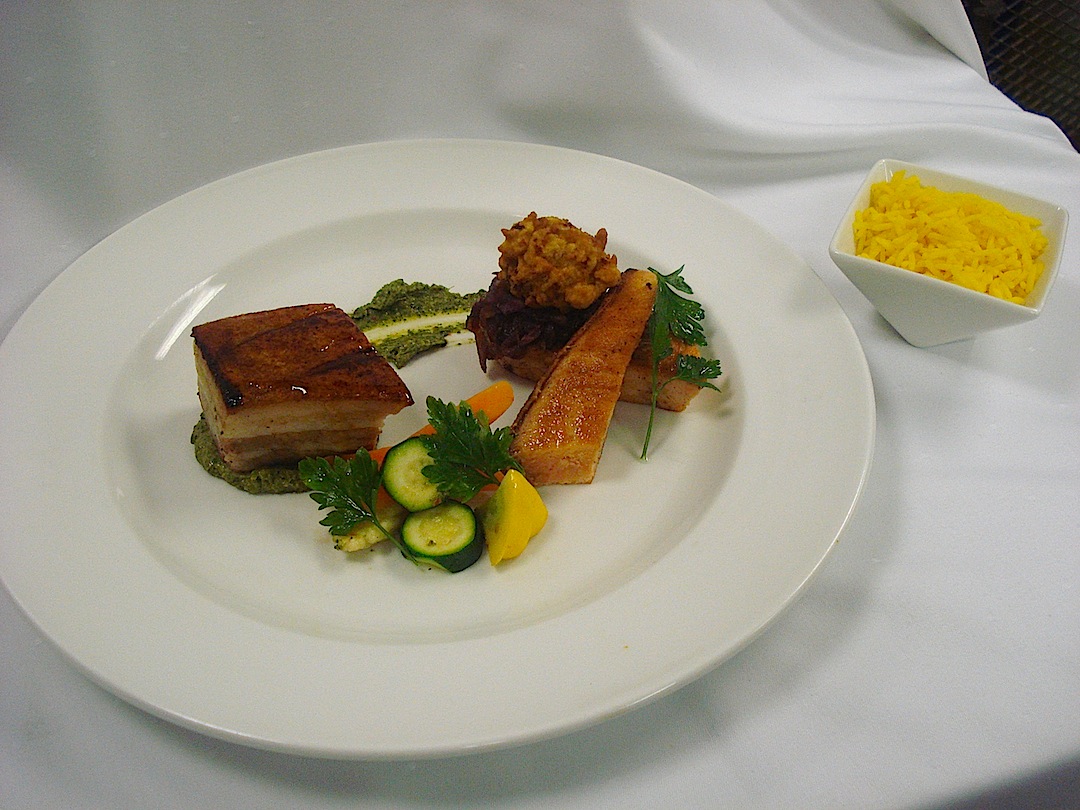 columns and
walls with deep square recesses containing huge
earthenware pots. And, as to be expected, patrons
ranged from suited businesspeople to casually dressed
tourists.
columns and
walls with deep square recesses containing huge
earthenware pots. And, as to be expected, patrons
ranged from suited businesspeople to casually dressed
tourists.
Some of the items sampled from a
frequently changing seasonal menu included: a
picturesque salad of fresh local greens, edible
flowers, sun-dried tomatoes and marinated mushrooms
drizzled with a light vinaigrette; a salad of
cooked-to-a-turn prawns with ripe, juicy tomatoes and
a flavorful tomato confit; thick slabs of dewy
kingclip (a very popular mild-flavored fish) from Cape
Town, served over creamy spinach and fluffy mashed
potatoes; baked rack of Karoo lamb served with minted
vegetables. And for dessert, try the chocolate torte,
served with chocolate ice cream and a poached glazed
pear.
Of note, service was prompt and
professional, with menu items carefully explained on
request. Also, a wide selection of sensibly priced
South African wines, many by the glass, is available.
Expect dinner for two, including wine, tax and tip to
cost about $100 to $120. Open daily for breakfast, lunch and
dinner.
PLETTENBERG
BAY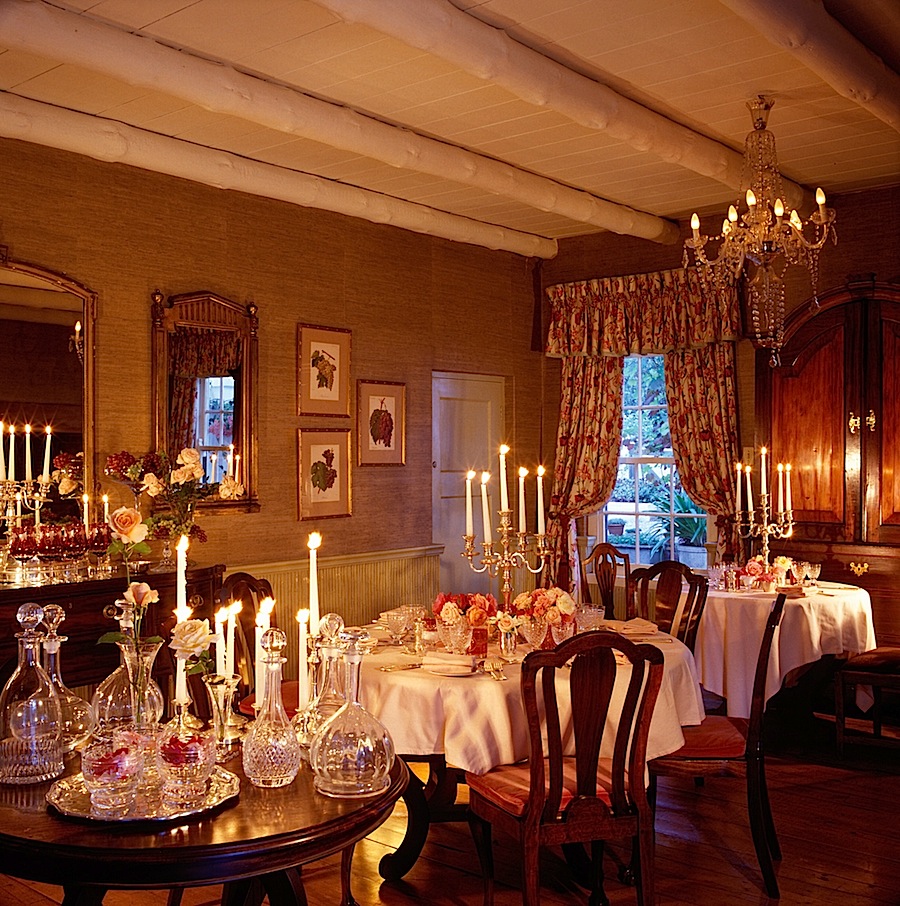
KURLAND HOTEL
The Crags
(044) 534 8082
www.kurland.co.za
With a
combination of exquisite cuisine, right-on wine
pairings of South African wines, luxurious setting and
flawless, professional service, the fixed price Chef’s
Table dinner prepared by Chef Leon Coetzee and his
wife, as sous-chef, was the most outstanding meal of
our trip.
The setting: just the two of us in
a spacious, well-appointed library at a table set with
a lace cloth, fine china, silver and top-notch
stemware, and adorned with a magnificent bouquet of
freshly cut flowers. The food and wine: ethereal
lobster cappuccino with Piere Jordan Brut sparkling
wine; flavorful spinach ravioli topped with a buoyant
mustard foam mated with a dry, lemony single vineyard
chardonnay from Waterford Estate; beef tartare infused
with Asian spices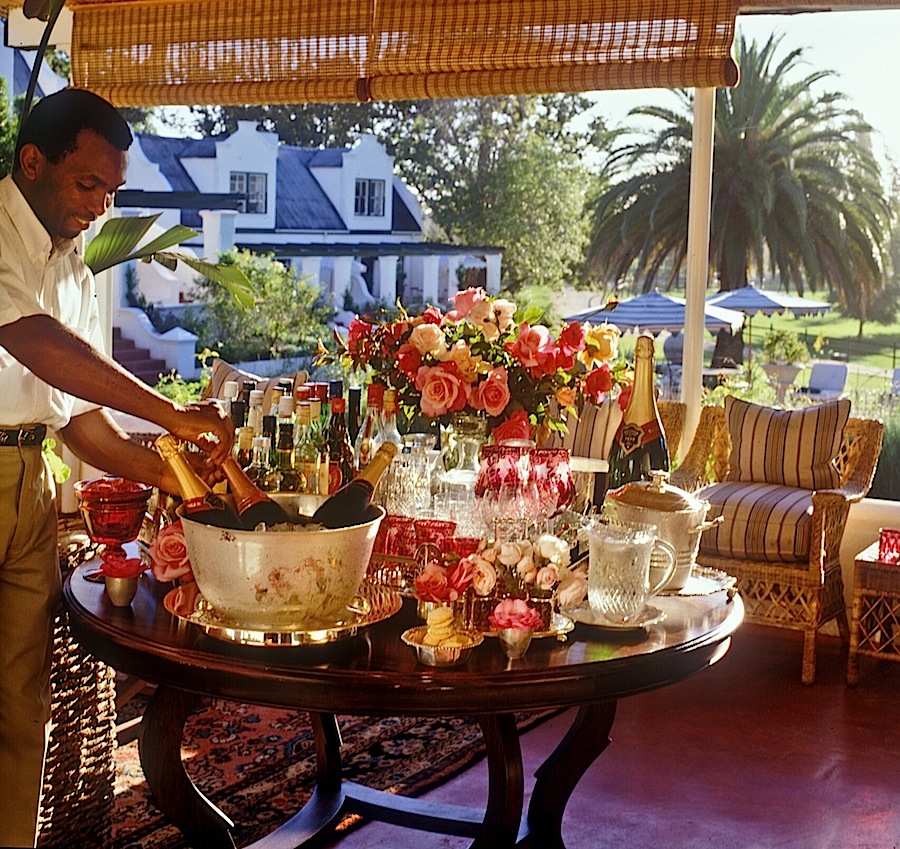 perfectly
paired with the deep plum flavors of the
Chocolate Block blend of syrah, grenache, cabernet
sauvignon, cinsault and viognier from
Boekenhoutskloof; pan-seared loin of lamb
drizzled with an earthy foie gras and truffle jus
accompanied by a complex Haute Babrer pinot noir;
delicate lemon-poached salmon, accompanied by organic
vegetables and topped with an addictive white
chocolate sauce matched with a crisp Waterford
Sauvignon Blanc; a rich, vanilla crème
brûlée served with a honeyed Delheim
Edelspatz Late Harvest Riesling; and a South African
cheese board with sherry.
perfectly
paired with the deep plum flavors of the
Chocolate Block blend of syrah, grenache, cabernet
sauvignon, cinsault and viognier from
Boekenhoutskloof; pan-seared loin of lamb
drizzled with an earthy foie gras and truffle jus
accompanied by a complex Haute Babrer pinot noir;
delicate lemon-poached salmon, accompanied by organic
vegetables and topped with an addictive white
chocolate sauce matched with a crisp Waterford
Sauvignon Blanc; a rich, vanilla crème
brûlée served with a honeyed Delheim
Edelspatz Late Harvest Riesling; and a South African
cheese board with sherry.
The service: Well spaced courses
with explanation of each course by the waiter or the
chef.
The price:
amazingly only $205 for two including, wine, tax and
tip.
KNYSNA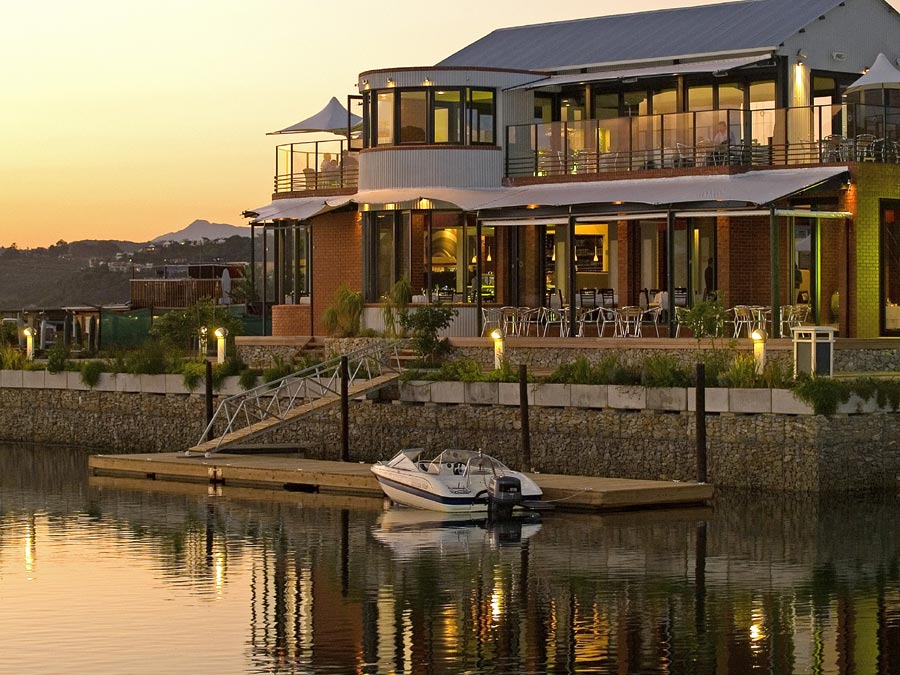
SIROCCO
18 Thesen Harbour Town
(044)-382-4874
www.sirocco.co.za
Named for
the warm, dry breeze that originates in the Sahara and
sweeps across the Mediterranean Sea, this casual
restaurant is situated on the wharf of the Thesen
Harbour Town development. Both outdoor and indoor
seating are available, with a mesmerizing view of the
sunset. Moreover, featuring a wide range of expertly
prepared dishes, this is not your typical waterfront
view-deep fried fish-and-chips spot.
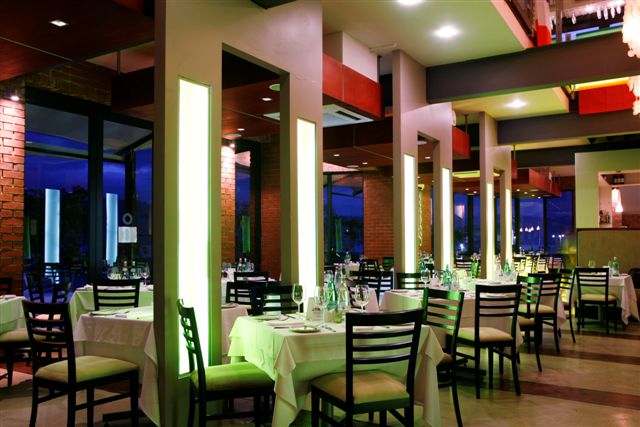 For starters, a
prawn and mango salad had well integrated flavors of
ripe fruit and briny sea, the seared calamari
pristinely fresh and cooked to a perfect, silky-smooth
consistency; and the heady South-African specialty,
peri-peri
chicken livers that showed over-the-top intensely rich
and piquant flavors. Two main courses sampled were the
combination of cooked-to-a-turn calamari and local
line-caught hake with a lemon-butter sauce, and Queen
Prawns bathed in peri-peri
sauce. Both went well with a soft, fruity, 2011 Protea
Shiraz.
For starters, a
prawn and mango salad had well integrated flavors of
ripe fruit and briny sea, the seared calamari
pristinely fresh and cooked to a perfect, silky-smooth
consistency; and the heady South-African specialty,
peri-peri
chicken livers that showed over-the-top intensely rich
and piquant flavors. Two main courses sampled were the
combination of cooked-to-a-turn calamari and local
line-caught hake with a lemon-butter sauce, and Queen
Prawns bathed in peri-peri
sauce. Both went well with a soft, fruity, 2011 Protea
Shiraz.
And a dessert of Macadamia nut
brownie served with rich, vanilla ice cream made a
perfect finish.
Expect dinner for
two to cost $60-$65, including wine, tax and tip. Open daily for lunch
and dinner.
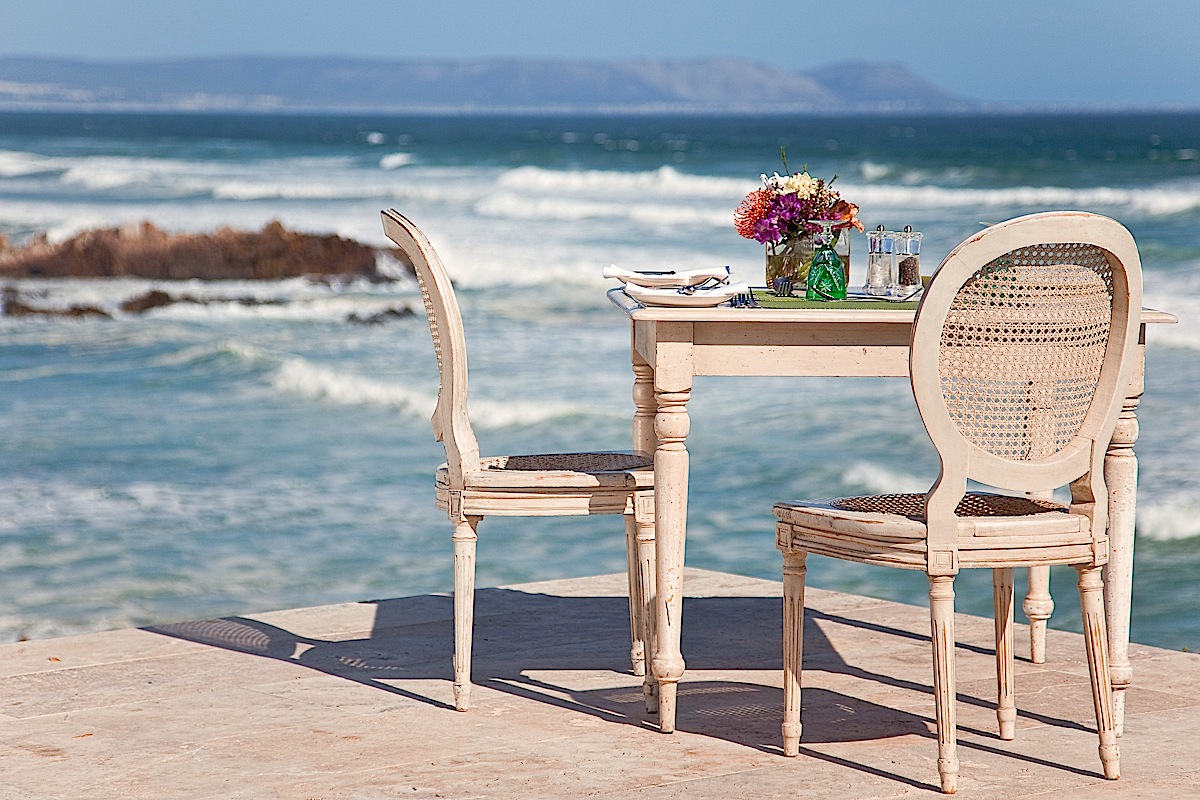 HERMANUS
HERMANUS
BIRKENHEAD
HOUSE
119 11th Street
(028) 314-8000
www.birkenheadhouse.com
Dining here
is limited to overnight guests of this small plush
hotel, magically set on rugged cliffs high above the
southern coast of the Western Cape. Guests can chose
to dine in a spacious, glass-fronted sea-facing room
from which, in season, you can see Right Whales
splashing high above the surface; or, in a
flower-strewn suite (some of which also overlook the
water) or, weather-permitting, outdoors on a precipice
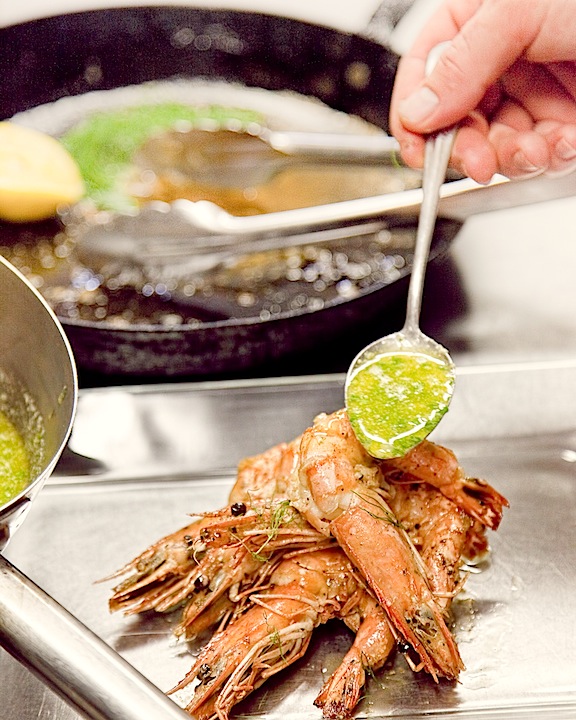 atop the cliff.
atop the cliff.
The overall theme here is the
fusion of local fare with French cooking techniques
and strong influences of Asian and Italian cuisines,
especially spicing. For example: a starter of fresh
butter-sautéed Tiger Prawns (right) had subtle
hints of garlic and Thai basil; and moist, pan-fried
Cape Town kingclip was accompanied by perfectly cooked
risotto primavera rich with Parmesan cheese; and a
thick grilled beef fillet topped with Blue cheese was
served with a roasted tomato and pommes gratin
flavored with truffle oil.
Following the same theme, a dessert
of chocolate and almond spring rolls with vanilla ice
cream and fresh berries showed a happy mélange
of French, Asian and Italian influences. Of note, the
fare, whether from the sea or land, mated quite well
with a ripe fruity 2009 de Meye Stellenbosch Shiraz
that was suggested by one of the friendly, highly
professional servers.
The all inclusive
price for two guests including room, meals, local
wine, tax and gratuity ranges from $600 to $1400
depending on the season and size and location of the
room. Open daily for breakfast, lunch and dinner.
 FRANSCHHOEK
FRANSCHHOEK
THE TASTING
ROOM at LE QUARTIER FRANCAIS
16 Huguenot Road
(021) 876 8442
www.lqf.co.za
If you crave
cutesy, deconstructed set-menu fare served in a rather
stark, foliage-free ambiance, accompanied by
pre-matched wine selections, this is the place for you
to dine. The buzz here is about award-winning chef
Margot Janse, and patrons ooh and ah about the
offerings. We found the experience interesting, but
somewhat lacking -- a combination of NYC’s “WD-50
Heavy” and “Blue Hill at Stone Barns Lite.”
After an amuse bouche of a cold
foie gras wafer and a tiny squid ink brick, our dinner
progressed to a small, smooth, deep red orb with
intense beet flavor accompanied by cucumber granita
mated with a very young chenin blanc – a pairing we
found jarringly bitter. Next we were served a small
portion of heady, curry-dusted dewy kingclip,
accompanied by overly cumin-doused dal, kale and
tomato confit -- a dish that ran over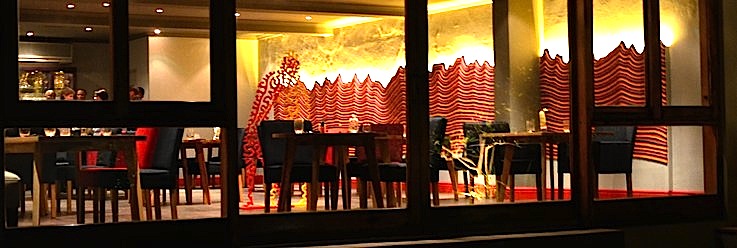 a
rather one-dimensional Semillon. This was
followed by a juicy loin of Karoo springbok served
with wild grains, rainbow carrots and celeriac with a
jammy 2010 Moreson Pinotage (the best wine-food
match of the evening).
a
rather one-dimensional Semillon. This was
followed by a juicy loin of Karoo springbok served
with wild grains, rainbow carrots and celeriac with a
jammy 2010 Moreson Pinotage (the best wine-food
match of the evening).
The repast concluded with some
excellent local Gruyère cheese, its flavor
enhanced by a very delicate South African port, and
some gastronomic hocus pocus involving a puffy
balloon-shaped coconut dessert that deflated with the
addition of caramel sauce. The price of admission was
$225 for two, including food, wine, tax and tip – a
bargain and a half for those into this type of
culinary adventure, especially when compared with
other similarly themed establishments in the U.S. and
France.
Open Tuesday through
Saturday for dinner only
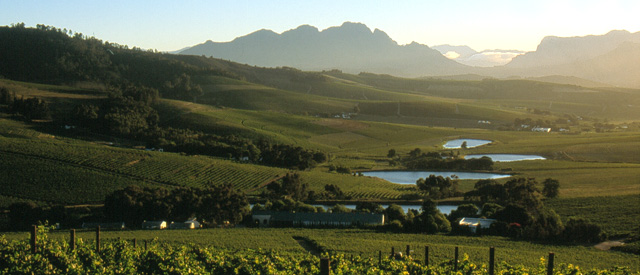
STELLENBOSCH
JORDAN
RESTAURANT
Stellenbosch Kloof Road
(021) 881 3612
www.jordanwines.com
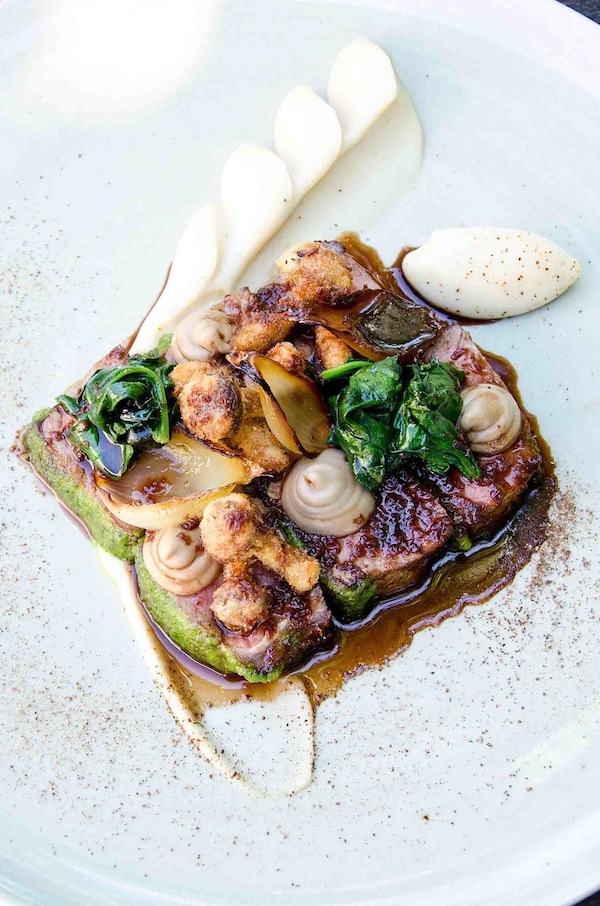 Set amidst the
bucolically beautiful hillside vineyards of Jordan Winery,
with distant views of False Bay and Table Mountain,
this is a prime place to enjoy a leisurely, very
reasonably priced, memorable lunch. From a daily
changing menu of locally sourced items carefully
selected by award-winning chef George Jardine, we
chose creative starters that included a chilled
Gorgonzola-infused cauliflower panna cotta and an
Asian-spiced carpaccio of yellowfin tuna. For main
courses we went with a steamed local Kabeljou fish
accompanied by an aromatic bouillon of organic summer
vegetables and herbs. A roasted line-caught
white stumpnose (sea bream) was accompanied by roasted
potatoes and creamed spinach served with a creamy,
decadent aïoli-like sauce. Of course, we
accompanied the fare with glasses of current vintages
of Jordan Chardonnay and Cabernet, and for dessert we
delved into a gratin of fresh summer berries afloat in
a strawberry soup, topped with a berry sorbet.
Set amidst the
bucolically beautiful hillside vineyards of Jordan Winery,
with distant views of False Bay and Table Mountain,
this is a prime place to enjoy a leisurely, very
reasonably priced, memorable lunch. From a daily
changing menu of locally sourced items carefully
selected by award-winning chef George Jardine, we
chose creative starters that included a chilled
Gorgonzola-infused cauliflower panna cotta and an
Asian-spiced carpaccio of yellowfin tuna. For main
courses we went with a steamed local Kabeljou fish
accompanied by an aromatic bouillon of organic summer
vegetables and herbs. A roasted line-caught
white stumpnose (sea bream) was accompanied by roasted
potatoes and creamed spinach served with a creamy,
decadent aïoli-like sauce. Of course, we
accompanied the fare with glasses of current vintages
of Jordan Chardonnay and Cabernet, and for dessert we
delved into a gratin of fresh summer berries afloat in
a strawberry soup, topped with a berry sorbet.
The cost of lunch
for two, not including wine, tax or tip was $65.
Open for lunch Tuesday –Sunday and dinner Thursday
and Friday
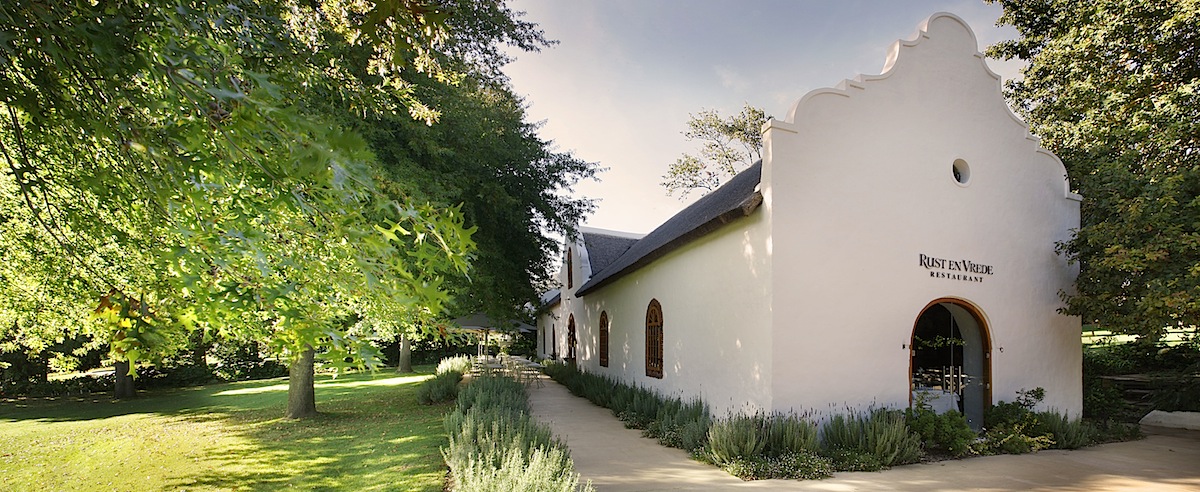 RUST EN
VREDE
RUST EN
VREDE
Annandale Road
(021) 881 3000
www.rustenvrede.com
Meaning “rest
and peace,” this restaurant housed in what was once a
winery cellar, a few miles outside the center of
Stellenbosch, is not your typical “little ole country
eatery,” perennially placing in San Pellegrino’s list
of top 100 restaurants in the world. Inside, tables
are set with fine linens, Riedel stemware and dishware
made by local master potter David Walters. The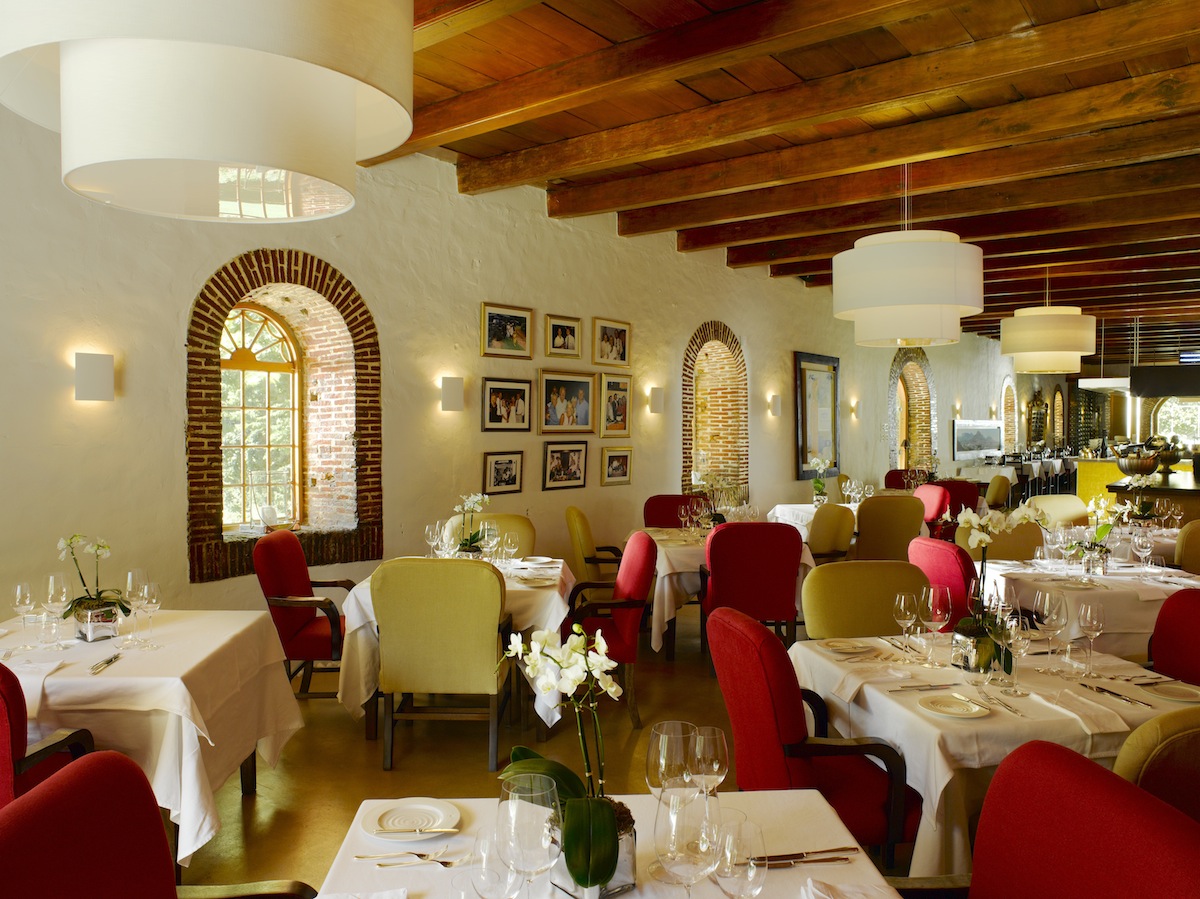 tables surround an open kitchen where
chef John Shuttleworth and his staff use classic and
modern French techniques to cook primarily locally
sourced ingredients. Overseen by the chef’s wife,
Andrea, service is prompt, friendly and professional,
with brief sensible discourses on the menu choice.
tables surround an open kitchen where
chef John Shuttleworth and his staff use classic and
modern French techniques to cook primarily locally
sourced ingredients. Overseen by the chef’s wife,
Andrea, service is prompt, friendly and professional,
with brief sensible discourses on the menu choice.
From the four-course menu we
started with a combination of duck confit and foie
gras garnished with red radish and rhubarb, and the
ubiquitous kingclip cleverly served with perfectly
matched accompaniments of cauliflower, pancetta and a
Gruyère beignet. For a second course we chose a
meaty roasted quail and a dewy monkfish tail paired
with Parma ham, porcini
and baby leeks.
Next we both chose the medium-rare
loin of lamb, its flavor enhanced by pickled morels
and almond purée and served with mint pearl
barley. As to wine, we paired each selection with two
vintages (1996 and 2009) of the Rust en Vred Estate
Red Blend (cabernet sauvignon, shiraz and merlot).
The1996 showed a memorable bouquet and taste of
blackberries, anise and vanilla and the 2009 had a
fruit forward, plummy taste. Of note, the older wine
mated particularly well with the lamb, while the
younger showed a bit more fruit, marrying surprisingly
well with the duck confit and kingclip.
We concluded with a selection of
South African cheeses and a rich lemon thyme panna
cotta.
Four course dinners
cost $100 for two, not including wine, tax or tip,
with wine very sensibly priced. Open Tuesday –
Saturday for dinner
 CAPE TOWN
CAPE TOWN
THE ROUNDHOUSE
Roundhouse Road, The Glen, Camps Bay
(021) 438 4347
www.theroundhouserestaurant.com
Originally a
guardhouse built over 200 years ago by the Dutch East
India Company, the Roundhouse offers sweeping views
westward over historic Camps Bay. Inside, the
décor is woodsy-chic, with fine china and
silverware set on white linen-clothed tables set
primarily in a long room with dark wood on one side
and windows on the other, affording a view of the
distant sunset.
While a six-course fixed-price
tasting menu, with optional wine pairing, is
available, we went with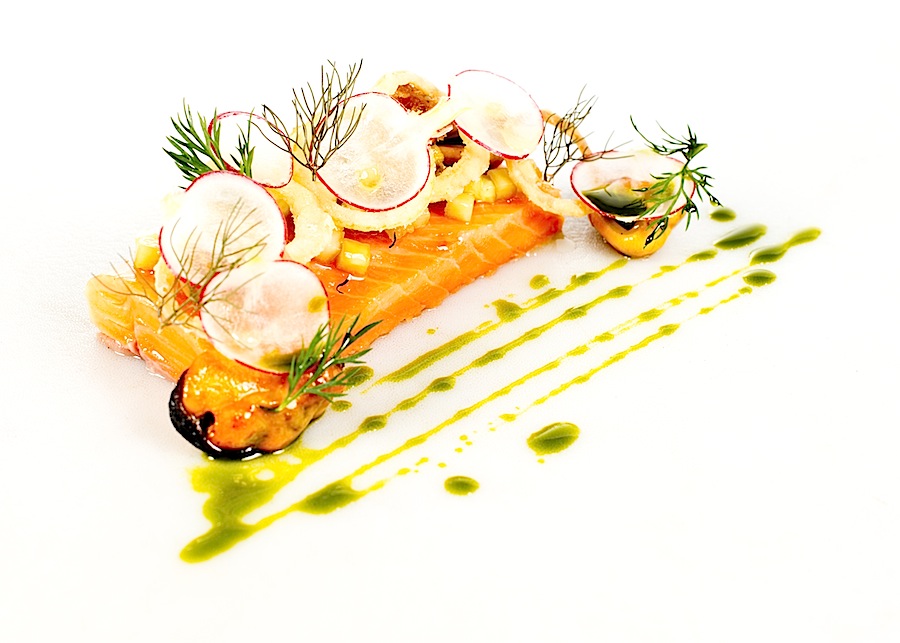 a dinner
consisting of four courses, with three to four choices
for each course. To begin, we chose a very imaginative
salad of supple globe artichoke leaves dressed with a
nutty butter emulsion whipped with a garlic
purée and almond juice, and a tender,
slow-cooked beef tongue, enlivened by a dab of
whole-grain mustard.
a dinner
consisting of four courses, with three to four choices
for each course. To begin, we chose a very imaginative
salad of supple globe artichoke leaves dressed with a
nutty butter emulsion whipped with a garlic
purée and almond juice, and a tender,
slow-cooked beef tongue, enlivened by a dab of
whole-grain mustard.
For the next two courses we each
chose anise-scented salmon trout poached in olive oil
and tender, rosy fallow deer, its flavor enhanced by
lingonberries and a marinade or rosemary and lavender.
We accompanied the meal with two top-tier South
African Bordeaux-like blends, a smooth 2006 Jordan
Cobler’s Hill Red, similar in style to a Lynch-Bages,
and a 2006 De Toren Z, with complex flavors of cassis
and dried cherries. Both matched the fare quite well,
with a slight edge to the Jordan, which paired
perfectly with the salmon trout as well as the deer. A
selection of rich South African cheeses and a
refreshing passion fruit soufflé with toasted
coconut sorbet provided an excellent ending.
The four course dinner, not including wine (which is
modestly priced), tax and tip cost a very reasonable
$110 for two.
Open
for dinner Tuesday - Saturday and for lunch
Wednesday – Sunday (May 1- September 30)
 SAVOY CABBAGE
SAVOY CABBAGE
101 Hout Street
(021) 424 2626
www.savoyvabbage.co.za
Diners here
shouldn’t be put off by the no-frills environment of
exposed brick walls, shiny, unadorned wooden tables
set with simple white dishes, and straightback
cushionless chairs. A welcome lack of piped-in music
allows for quiet conversation. Taking its name from
what many consider the prettiest and sweetest cabbage,
this is “the” Cape Town spot for cutting-edge,
eclectic fare. An interesting aside is that many
locals, even those into food and wine, like our superb
guide /driver during our trip, Caz Louw, consider this
place quite off-beat.
Starters of grilled asparagus with
mustard mayonnaise, 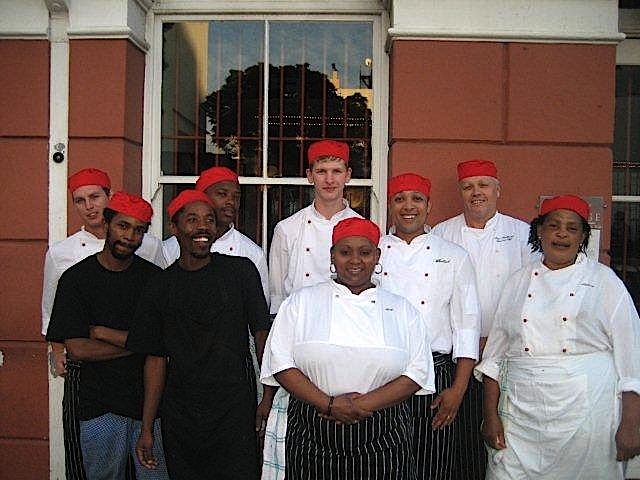 pickled quail’s egg and salad of
beetroot, orange and fennel with homemade labnah were au courrant
but not write-home-about avant-garde. However, main
courses of moist grilled hake on dried apricot and
almond pilaf with a fruity Malay butter sauce and
Karoo Lamb two ways -- roast crumbed loin and braised
shoulder with fondant potatoes and lamb thyme jus -- were
exceptional and not your everyday fare. And these were
some of the less “out there” choices, which included
spiced Kudu filet served rare, pickled lamb filet, and
fennel dusted Warthog on braised neeps.
pickled quail’s egg and salad of
beetroot, orange and fennel with homemade labnah were au courrant
but not write-home-about avant-garde. However, main
courses of moist grilled hake on dried apricot and
almond pilaf with a fruity Malay butter sauce and
Karoo Lamb two ways -- roast crumbed loin and braised
shoulder with fondant potatoes and lamb thyme jus -- were
exceptional and not your everyday fare. And these were
some of the less “out there” choices, which included
spiced Kudu filet served rare, pickled lamb filet, and
fennel dusted Warthog on braised neeps.
For dessert go with the day’s
specials, like cape malva pudding with vanilla
crème Anglaise or macerated strawberries on
hazelnut shortbread with milk chocolate ice cream.
Dinner for two, including tax, tip and two glasses of
wine each -- from a list of over two dozen
sensibly-priced South African choices -- was $130.
Open for dinner Monday – Saturday and Lunch Monday –
Friday.
Also, two
restaurants highly touted in guidebooks --Nobu and
Reubens -- located in the large and impersonal One & Only
hotel were just that, large and impersonal, and not
worthy of detailed mention. Suffice it to say that Nobu served
creditable food, but unless you have a sushi
addiction, why go all the way to South Africa to dine
on Japanese fare? And Reuben’s, which offered
all the charm of a breakfast, lunch and dinner spot in
a large downtown hotel, served ho-hum fare at upscale
prices.
Geoff Kalish, MD is a former wine
columnist for Wine
Spectator and the
NY Times (Westchester Weekly
Section) and co-author of The Best Wining & Dining in New
Orleans and
Wining and Dining in Westchester.
NEW YORK CORNER
(Suburban
Division)
by
John Mariani
 THE Ryland INN
THE Ryland INN
115 Old Highway 28
Whitehouse Station, NJ
908-534-4011
www.rylandinnnj.com
From
1991 through 2007, The Ryland Inn was known as one of
New Jersey’s finest restaurants, with an award-winning
chef, Craig Shelton, whose classic and nouvelle
cuisine was both highly personalized and highfalutin.
The Inn’s wine list was astoundingly rich, and,
at the time, when spending freely was part of the
ethos, hugely expensive wines were sold regularly.
The Inn itself was
very beautiful, set well off the road on
ten-and-a-half acres of rural New Jersey land in
Whitehouse, albeit proximate to suburban sprawl. It
was a place to celebrate, to hold weddings and to
enjoy a kind of cuisine that by 2005 was just
beginning to fade in popularity. Everything was
stylized to reek luxury, and pretentious presentations
were part of Shelton’s mission to impress.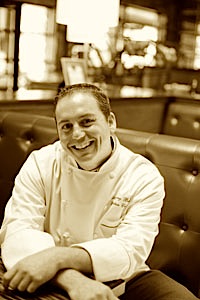
Oddly
enough,
a water main break led to disastrous management
disputes and eventual foreclosure in 2007, and the Inn
lay empty until construction industry exec Frank
Cretella and his wife, Jeanne, took it over last year,
poured in money and hard work, and, without
transforming the bucolic charms of the original
décor of this former stagecoach station,
brought a much-needed modernity to 13,000 square feet
of space, with 130 seats inside and out. With five
dining rooms, polished dark woods, cathedral ceilings
and Victorian Gothic arched windows, white
tablecloths, and equestrian artwork, the Inn retains
the look of a place that might easily be the home of
landed gentry, if New Jersey had landed gentry.
It’s a more casual
place now, less hushed, less reverential, and chef
Anthony Bucco, most recently at Uproot in Warren, has
replaced Shelton’s mannerisms with a more ebullient
personality. Still, some of his food can be overly
complex and plated as much for looks as for taste,
appearing to take more time to compose than to cook.
But, largely, taste trumps pomp here, beginning
with a dish of shrimp with watermelon radish and sunomono pickled
vegetables.
There is a healthy
dose of Asian flavors in his kitchen, including uni custard
with cauliflower mousse, tempura and kombu (kelp),
and he serves lush, silky kindai madai
(sea bream) crudo
(I’m not sure why he uses the Italian word instead of
sashimi) with crispy rice, pickled vegetables, and a
smoked cashew puree. Deep red
yellowfin tuna comes with pork belly, green lentils,
and black garlic, while mackerel is wrapped in thin
sheets of Italian lard, served with apple, rosemary,
cabbage in a pork broth.
Deep red
yellowfin tuna comes with pork belly, green lentils,
and black garlic, while mackerel is wrapped in thin
sheets of Italian lard, served with apple, rosemary,
cabbage in a pork broth.
I was happy to see
skate wings on the menu, here made into a roulade,
with fingerling potato, grilled spinach, and buttered
almonds. And the smoked squab breast with a rich
accompaniment of foie gras, the crunch of pistachios,
and sweet parsnip and pear was a triumph of perfectly
incorporated ingredients and textures. Similarly, the
delicacy of hare and rabbit
crêpinette with cauliflower and golden
raisins showed Bucco’s persuasive talent for classic
technique. Thickly cut filet mignon was enriched with
braised short rib, winter vegetables, and a reduction
of Bordeaux wine. Venison (it was early spring
when I dined there) came with chestnuts and a sweet
potato pave
that made for an honorably traditional marriage.
For dessert, the Inn’s
panna cotta
made with sheep’s milk came wrapped within a passion
fruit gel sprinkled with ginger granola. 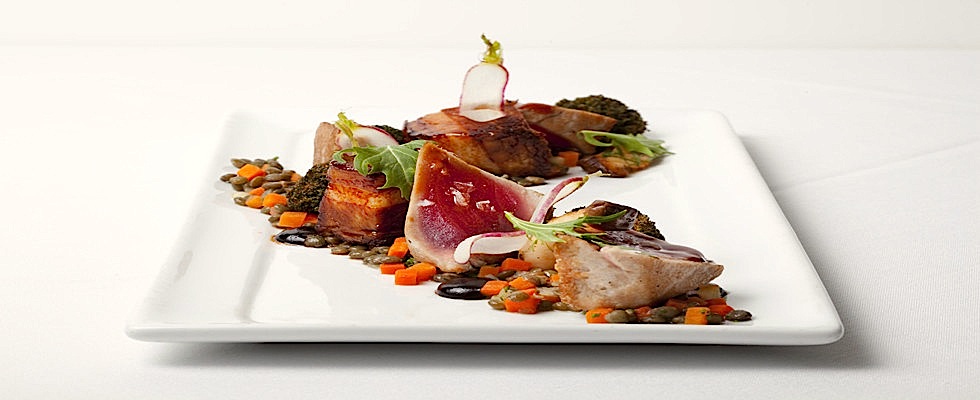 I am not much
of a peanut butter fan, but I admit that pastry chef
Jon Boot’s PB mousse coated with chocolate accompanied
by banana-Nutella ice cream was pretty darn good.
I am not much
of a peanut butter fan, but I admit that pastry chef
Jon Boot’s PB mousse coated with chocolate accompanied
by banana-Nutella ice cream was pretty darn good.
The wine list, not as
top heavy with exorbitant bottlings as it used to be,
is now very well budgeted and has depth and breadth.
The service staff is well meaning but slightly
behind the kitchen and ambiance in sophistication.
It’s wonderful to see
such a beautiful and revered place rescued and
restored to a contemporary refinement that shows in
the decorous details—this, obviously due to Mr.
Cretella’s expertise in construction—and it is now a
better restaurant than most people might remember it.
It’s a difficult thing to pull off, and the
vision the Cretellas have for the Ryland Inn’s future
seems assured.
The Ryland Inn is open Tues.-Sun.
for dinner. Appetizers run $12-$17, main
courses $29-$42, with a seven-course tasting menu at
$99.
♦ ♦ ♦
BIG LISTS AND HIGH PRICES: WHO BUYS THIS STUFF?
by John Mariani
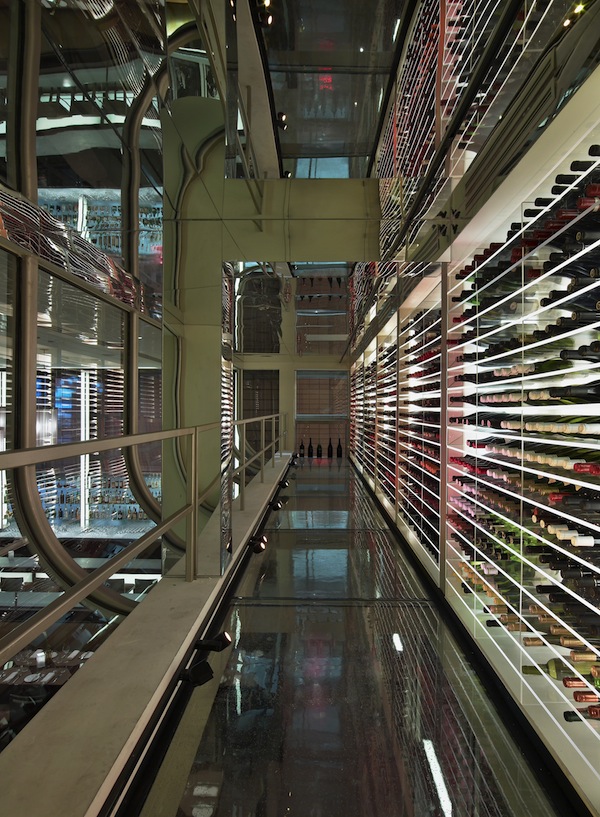
I apologized for being so entranced in Aureole’s list, but I was in awe of its having so many bottlings of particular wines, like 18 vintages of Domaine Leflaive and ten from the hard-to-get Harlan Estate, all within a stunning glass cache (right).
The list teems with great rarities, including two vintages of Domaine de la Romanée-Conti, a 2009 for $10,500 and a 2010 for $11,450 (which is actually something of a bargain, since those same wines sell in wine shops for even more). Aureole also lists scores of wines even connoisseurs are unlikely to seek out, including a $50 Alsatian chasselas. I asked wine director Justin Lorenz, “When was the last time you actually served a chasselas?” “As a matter of fact,” he said, “just last weekend. A guest wanted to try something he’d never had before at around that price, so I recommended it. There are great values on our list from Alsace, Austria, and Switzerland, and I steer people to them when they tell me what they want to spend.”
So who these days buys a $10,000 burgundy? “I’ll sell four or five $300 to $500 bottles every night,” said Lorenz. “Above $500, a couple of bottles per month. For wines $1,000 and up, Americans don’t order many, but some of our South American and Chinese clientele do.”
Many restaurants build huge “trophy” wine lists for prestige, hoping to join the 75 restaurants that currently hold Wine Spectator’s Grand Award for cellars that “generally offer 1,500 or more selections, with superior breadth and depth in many of the world’s classic wine-producing regions.” One winner, Bern’s Steak House in Tampa, FL, has a whopping 6,800 labels and 500,000 bottles.
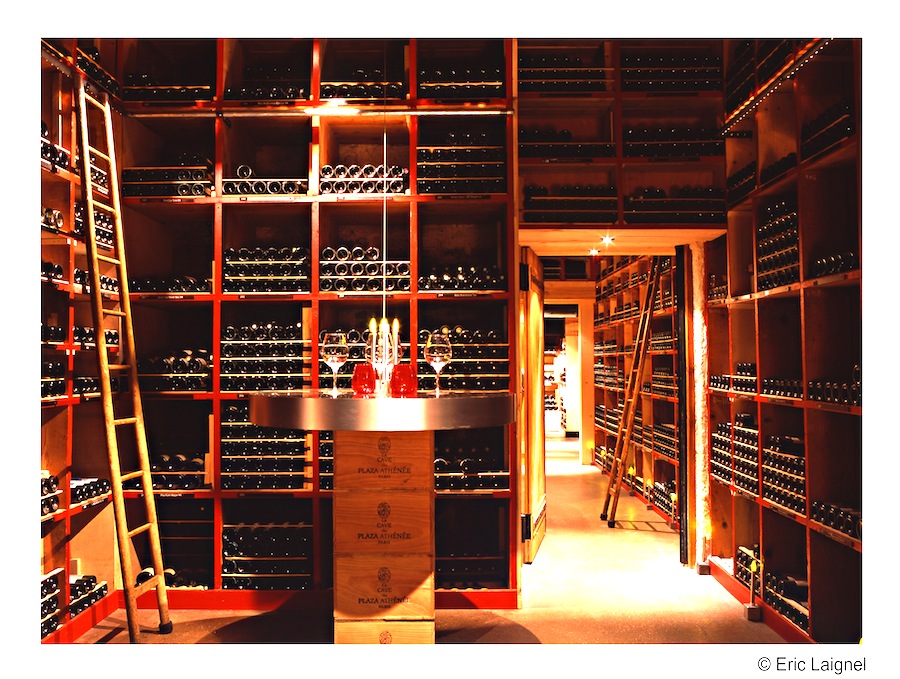 At the Plaza-Athenée
Paris Hotel, whose Michelin three-star Alain
Ducasse restaurant cellar (left) stocks 1,000 labels and
35,000 bottles, Laurent Roucayrol, just crowned Best
Sommelier of the year by L’Académie
Internationale de la Gastronomie, concurs that “the
Russians
and Chinese are the clients that seem less concerned
by the price of the bottle. Most people are drinking
less but better. For our business clients wine by
the glass is becoming increasingly popular, with an
average of two glasses per person. Sensitivity is
the main concern for me. I do my best to please them
by selecting a wine closest to their expectations.”
At the Plaza-Athenée
Paris Hotel, whose Michelin three-star Alain
Ducasse restaurant cellar (left) stocks 1,000 labels and
35,000 bottles, Laurent Roucayrol, just crowned Best
Sommelier of the year by L’Académie
Internationale de la Gastronomie, concurs that “the
Russians
and Chinese are the clients that seem less concerned
by the price of the bottle. Most people are drinking
less but better. For our business clients wine by
the glass is becoming increasingly popular, with an
average of two glasses per person. Sensitivity is
the main concern for me. I do my best to please them
by selecting a wine closest to their expectations.”These new economies for business meals are a far cry from the “Mad Men” days of three-martini lunches and First Growth bordeaux. Today, for many business people drinking at lunch is not encouraged; staying lucid is considered common sense. “I entertain clients at lunch two or three times a week,” says Anthony J. Forgione, Assistant VP for Hudson Valley Bank in White Plains, NY, “and I’d say only about 20 percent of them order even a glass of wine at lunch.”
Hosts are also increasingly on restrained expense accounts. “Presently my limit for a business meal, including wine, per guest is £80 ($120),” says Seema Arora, Global Head of Portfolio Trading Sales for
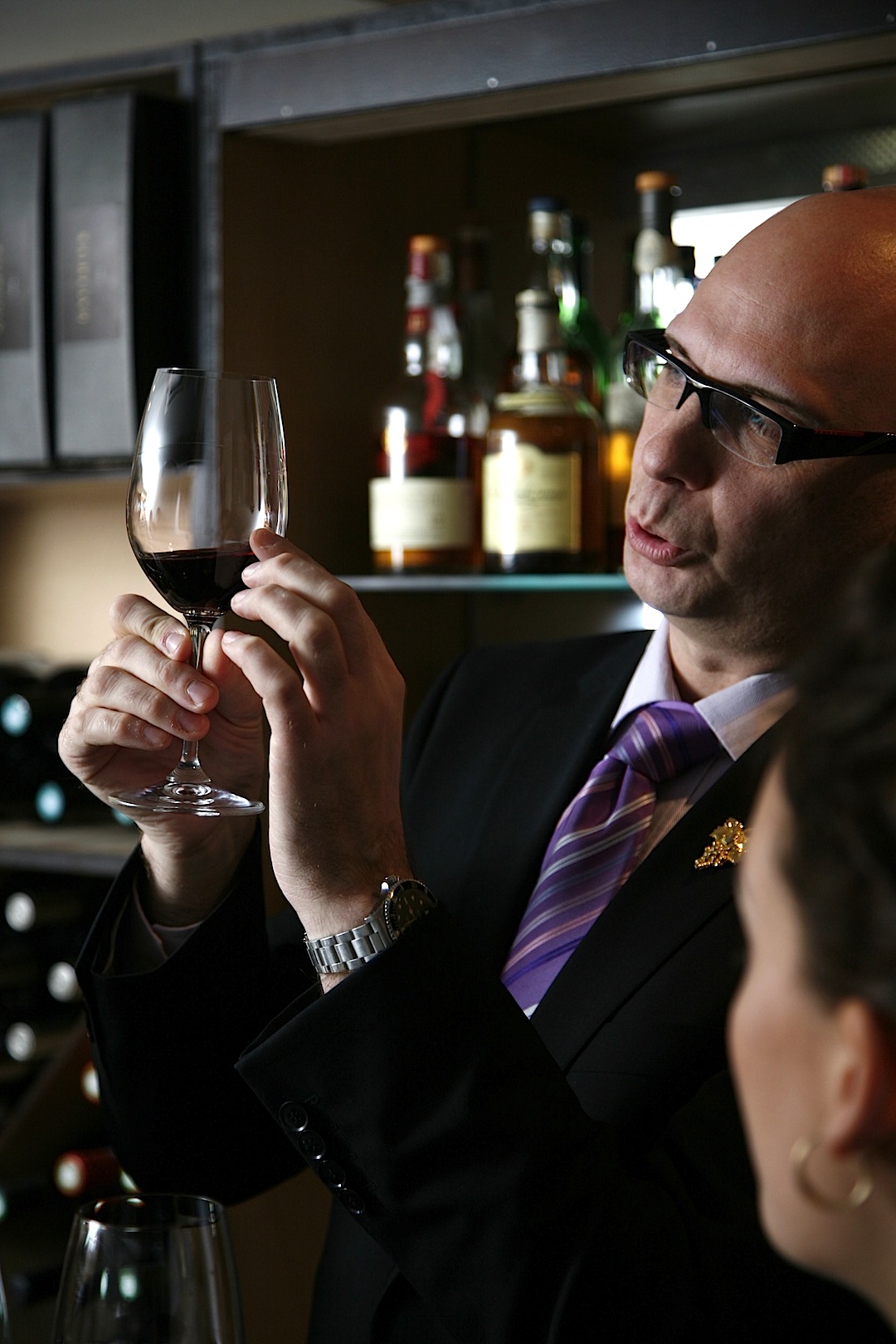 Crédit Agricole Cheuvreux
International Ltd, in London. “I can certainly go
over that if necessary, but I don’t spend hundreds
of pounds for wine at a business meal.”
Crédit Agricole Cheuvreux
International Ltd, in London. “I can certainly go
over that if necessary, but I don’t spend hundreds
of pounds for wine at a business meal.”In such a business environment, how does a new restaurant build a wine list from scratch to meet guests’ expectations? “Buying trophy wines is often done just to please the ego of the restaurateur or sommelier,” says Roberto Della Pietra (right), wine consultant for London’s four-week old Tartufo in Chelsea. “If you have a telephone and a checkbook anyone can build a huge list, and there is a thin line between being bright and being arrogant. My job is to have wines that elevate the cuisine of our chef Manuel Oliveri, with some little gems on it.”
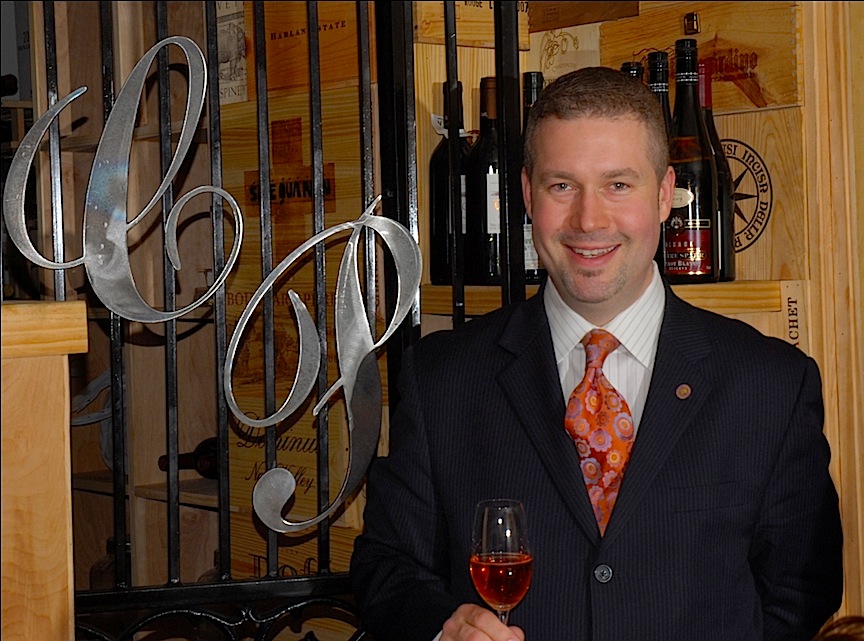 With an
average wine bill of £15 at lunch and
£25 at dinner, Della Pietra says, “We are
testing what the customer wants. I’m not going to
built the wine list on big expensive names.”
With an
average wine bill of £15 at lunch and
£25 at dinner, Della Pietra says, “We are
testing what the customer wants. I’m not going to
built the wine list on big expensive names.” One of the few cities where wine is still enjoyed at lunch is New Orleans, where people always find something to celebrate at the drop of a hat. “It’s still show-off time in this city,” says Ti Martin, co-proprietor of Commander’s Palace, whose cellar, overseen by beverage director Dan Davis (left) stocks 2,500 labels, the rarest behind iron gates. “A lot of people fly in just because we have the Grand Award, and they order some big old wines. It’s an over-the-top, I’m-going-to-treat myself experience for them, and they don’t skimp.”
Still, restaurants like Commander’s Palace must constantly come up with ways to sell more wine, especially older bottlings. “In our slowest months, August and September, we hold our `Grape Nuts’ sale, with 150 bottles at half price, which helps us to manage our inventory. And we brought back a silly thing from the past—the twenty-five cent martini (limit three per person). What happens is that it primes people to have one, then say, what the hell, and they order a $20 glass of Meursault.”
♦ ♦ ♦

"I have nothing
against hamburgers; a well-made one can be terrific,
and often (or a couple of times a year, anyway) it’s
just what I want. For the most part, though, I find
sausages more interesting, and more fun to make at
home."--David Tanis, "Lamb Sausage Edges Out the
Hamburger," NY
Times (6/7)
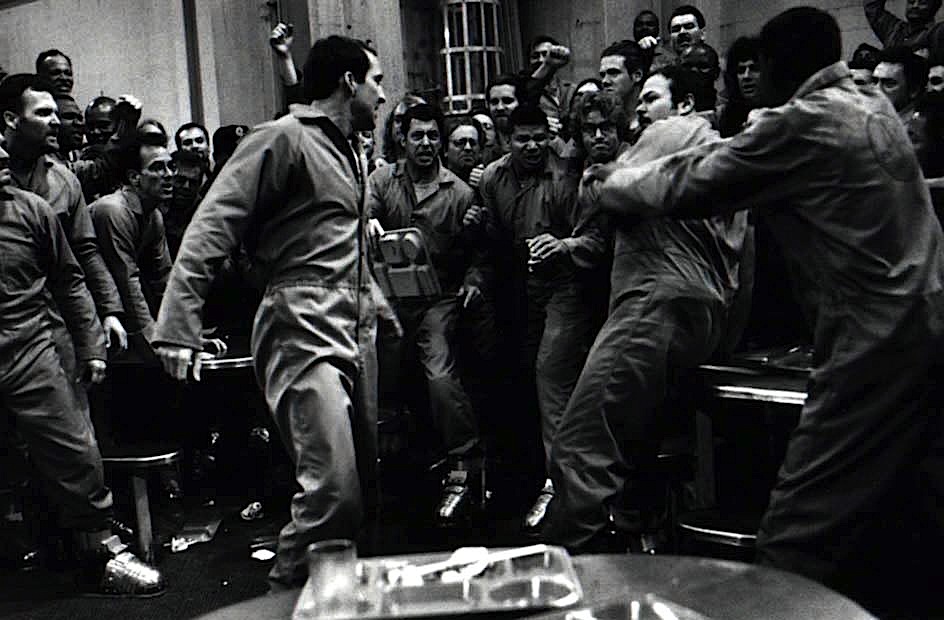
OH MY GOD! PLEASE! NOT
THE NUTRALOAF!
ANYTHING
BUT
THE NUTRALOAF!!!
Any of John Mariani's
books below may be ordered from amazon.com.
 |
My latest book, which just won the prize for best book from International Gourmand, written with Jim Heimann and Steven Heller, Menu Design in America, 1850-1985 (Taschen Books), has just appeared, with nearly 1,000 beautiful, historic, hilarious, sometimes shocking menus dating back to before the Civil War and going through the Gilded Age, the Jazz Age, the Depression, the nightclub era of the 1930s and 1940s, the Space Age era, and the age when menus were a form of advertising in innovative explosions of color and modern design. The book is a chronicle of changing tastes and mores and says as much about America as about its food and drink.
“Luxuriating vicariously in the pleasures of this book. . . you can’t help but become hungry. . .for the food of course, but also for something more: the bygone days of our country’s splendidly rich and complex past. Epicureans of both good food and artful design will do well to make it their coffee table’s main course.”—Chip Kidd, Wall Street Journal.
“[The menus] reflect the amazing craftsmanship that many restaurants applied to their bills of fare, and suggest that today’s restaurateurs could learn a lot from their predecessors.”—Rebecca Marx, The Village Voice. |
"Eating Italian will never be the same after reading John Mariani's entertaining and savory gastronomical history of the cuisine of Italy and how it won over appetites worldwide. . . . This book is such a tasteful narrative that it will literally make you hungry for Italian food and arouse your appetite for gastronomical history."--Don Oldenburg, USA Today. "Italian
restaurants--some good, some glitzy--far
outnumber their French rivals. Many of
these establishments are zestfully described
in How Italian Food Conquered the World, an
entertaining and fact-filled chronicle by
food-and-wine correspondent John F.
Mariani."--Aram Bakshian Jr., Wall Street
Journal.
"Equal parts
history, sociology, gastronomy, and just
plain fun, How Italian Food Conquered the
World tells the captivating and delicious
story of the (let's face it) everybody's
favorite cuisine with clarity, verve and
more than one surprise."--Colman Andrews,
editorial director of The Daily
Meal.com. "A fantastic and fascinating
read, covering everything from the influence
of Venice's spice trade to the impact of
Italian immigrants in America and the
evolution of alta cucina. This book will
serve as a terrific resource to anyone
interested in the real story of Italian
food."--Mary Ann Esposito, host of PBS-TV's
Ciao
Italia. "John Mariani has written the
definitive history of how Italians won their
way into our hearts, minds, and
stomachs. It's a story of pleasure over
pomp and taste over technique."--Danny Meyer,
owner of NYC restaurants Union Square Cafe,
Gotham Bar & Grill, The Modern, and
Maialino.
|
 |
 |
 |
 |
 |
 |
 |
 |
 Everett Potter's Travel Report:
Everett Potter's Travel Report: 
 Eating Las Vegas
is the new on-line site for Virtual Gourmet
contributor John A. Curtas., who since 1995
has been commenting on the Las Vegas food
scene and reviewing restaurants for Nevada
Public Radio. He is also the
restaurant critic for KLAS TV, Channel 8 in
Las Vegas, and his past reviews can be
accessed at KNPR.org.
Click on the logo below to go directly to
his site.
Eating Las Vegas
is the new on-line site for Virtual Gourmet
contributor John A. Curtas., who since 1995
has been commenting on the Las Vegas food
scene and reviewing restaurants for Nevada
Public Radio. He is also the
restaurant critic for KLAS TV, Channel 8 in
Las Vegas, and his past reviews can be
accessed at KNPR.org.
Click on the logo below to go directly to
his site.

Tennis Resorts Online: A Critical Guide to the World's Best Tennis Resorts and Tennis Camps, published by ROGER COX, who has spent more than two decades writing about tennis travel, including a 17-year stretch for Tennis magazine. He has also written for Arthur Frommer's Budget Travel, New York Magazine, Travel & Leisure, Esquire, Money, USTA Magazine, Men's Journal, and The Robb Report. He has authored two books-The World's Best Tennis Vacations (Stephen Greene Press/Viking Penguin, 1990) and The Best Places to Stay in the Rockies (Houghton Mifflin, 1992 & 1994), and the Melbourne (Australia) chapter to the Wall Street Journal Business Guide to Cities of the Pacific Rim (Fodor's Travel Guides, 1991).


MARIANI'S VIRTUAL GOURMET
NEWSLETTER is published weekly. Editor/Publisher: John
Mariani.
Contributing Writers: Christopher Mariani, Robert Mariani,
John A. Curtas, Edward Brivio, Mort Hochstein,
Suzanne Wright, and Brian Freedman. Contributing
Photographers: Galina Stepanoff-Dargery,
Bobby Pirillo. Technical Advisor: Gerry McLoughlin.
© copyright John Mariani 2013
